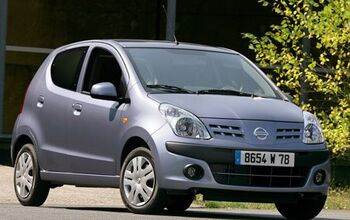Nissan's Only Problem: Not Enough Cars

Pronounced near-dead in 1999, Nissan has made a remarkable, but often unnoticed turn-around ever since. With little fanfare, the Yokohama company passed Honda as Japan’s second largest auto maker. In China, the land of car growth, Nissan sold 1.3 million cars last year, became largest Japanese brand and has expansion plans for 2.3 million. Nissan is also the company that recovered fastest from the March 11 tsunami. With only 25 percent of its world output in Japan, Nissan had less exposure that Honda, and especially Toyota. It also was lucky: Nissan could duck the chip shortage that hit Toyota and Honda with full force. Nissan’s engine factory in Iwaki is 60 miles away from Fukushima. A little closer, and it would still be closed. Instead, it was back up and running two months after the disaster. One of the most horrific years for Japan and the Japanese auto industry is shaping up to be the defining year for Nissan. Nissan’s biggest problem: Not enough cars.
“At the moment, we’ve only got one problem – making enough cars. I’ve got back orders for 30,000 cars in Mexico, 20,000 in Latin America. In Europe, even though they’re working seven days a week with shifts, I’ve got orders going back for two months on Qashqai.”
This is what Nissan Chief Performance Officer and Executive Vice President Colin Dodge today said in an interview in Yokohama. In Mexico, the soft underbelly of the U.S., Nissan holds on to an amazing market share of 26.4 percent. Most of the growth of Nissan comes from emerging markets, and Nissan hasn’t even covered all the BRIC markets yet. In China, Nissan is strong. In Russia, Brazil and India, Nissan has “just started,” as Dodge admits.
By the end of this calendar year, both Toyota and Honda will have produced significantly fewer cars than in 2010. Nissan on the other hand already produced 150,000 cars more than in 2010. Says Dodge:
“We’ve recovered from the earthquake as a company, it seems like, about two months quicker than Toyota, and Honda is still not recovered.”
Dodge’s boss, Carlos Ghosn, has another problem: The obscenely high yen. A chief of production doesn’t have his eyes on exchange rates:
“The yen, of course, is unfortunate. However, we’re doing our best to mitigate the effects of the yen. We’re praying for the Japanese government to do something in terms of quantitative easing. If not, it’s looking pretty dark, obviously, but I wouldn’t be depressed for the next six to eight weeks. Let’s make some cars, and sell the cars in the system.”

Bertel Schmitt comes back to journalism after taking a 35 year break in advertising and marketing. He ran and owned advertising agencies in Duesseldorf, Germany, and New York City. Volkswagen A.G. was Bertel's most important corporate account. Schmitt's advertising and marketing career touched many corners of the industry with a special focus on automotive products and services. Since 2004, he lives in Japan and China with his wife <a href="http://www.tomokoandbertel.com"> Tomoko </a>. Bertel Schmitt is a founding board member of the <a href="http://www.offshoresuperseries.com"> Offshore Super Series </a>, an American offshore powerboat racing organization. He is co-owner of the racing team Typhoon.
More by Bertel Schmitt
Latest Car Reviews
Read moreLatest Product Reviews
Read moreRecent Comments
- Rochester I'd rather have a slow-as-mud Plymouth Prowler than this thing. At least the Prowler looked cool.
- Kcflyer Don't understand the appeal of this engine combo at all.
- Dave M. This and the HHR were GM's "retro" failures. Not sure what they were smoking....
- Kcflyer Sorry to see it go. The interior design and color options in particular are rare in the industry
- Wolfwagen Here is my stable. not great not bad I try to do as much as possible. I work for an Aftermarket automotive parts company so I can get most parts at a discount.i try to do as much of my own work as possible. My wife hates that I spend time and money fixing the vehicles but she doesn't want car payments either so...2019 VW Atlas 50K (wife's) Only issues so far were Brakes and normal maintenance.A Bad Cat Converter which was covered and a replacement of the rear bank head gasket which was a manufacturing defect due to improper torquing at the factory. All under warranty2003 Saab 9-5 Arc Wagon (my DD) 116 K picked up used last year. Replaced Struts, brakes, hatch struts, motor mounts, D/S swaybar link, Timing belt, water pump and thermostat Power steering pump Fuel pump, Both Front window regular rollers, Heater core and cabin air filter. Oil and transmission changes. Love the car but Saab/GM packaging is a nightmare.2005 Cadillac Deville (former DD now Son # 1 DD) picked up used 5 years ago with only 47K now 83K Plugs, coils, P/s pump, Water pump, hoses, P/S lines (mechanic job) evap valve, brakes, Front brake calipers and rear brake calipers. Currently has oil pan gasket leak - looking to have a mechanic do that2009 Mini Cooper (Daughters dd)picked up 2 years ago 67K Brakes and thermostat house to clear check engine light2001 Mazda Tribue (Son#2 dd) 106K picked last summer after he severely damaged a 2004 Hyundai accent. Oil changes

































Comments
Join the conversation
I thought Nissan in Japan had a stroke of luck that it's facilities were nowhere near as affected as the Honda and Toyota facilities. IIRC, weren't they even further away from the afflicted areas?
I don't understand why Nissan is so aggressive with incentives when it's selling so well. Nissan should pad its bottom line by reducing unneeded incentives.